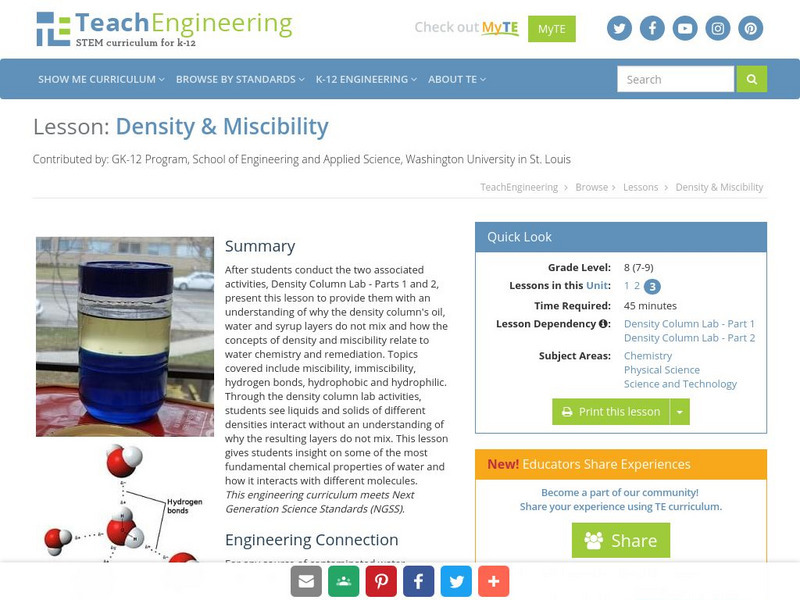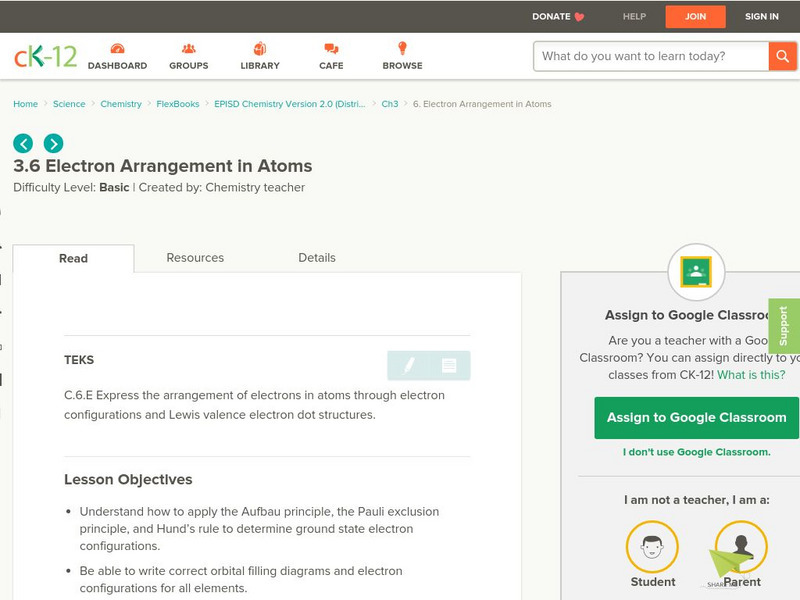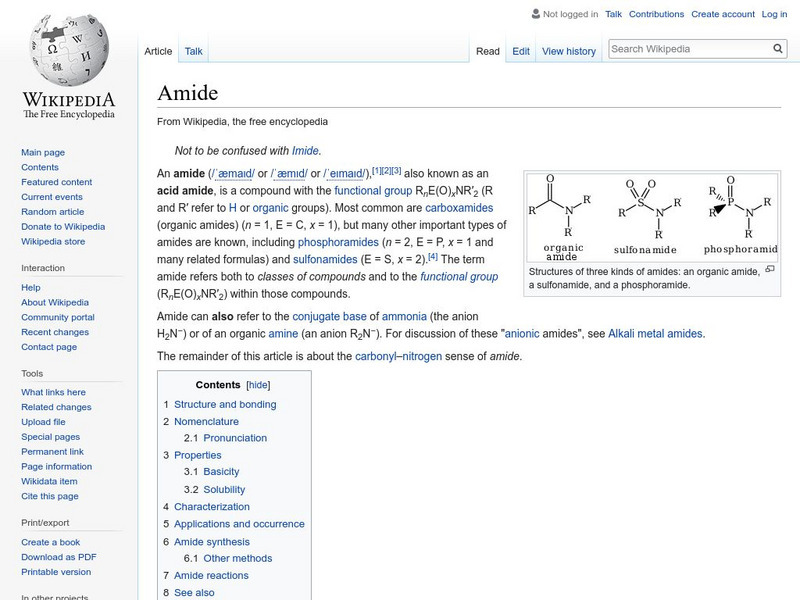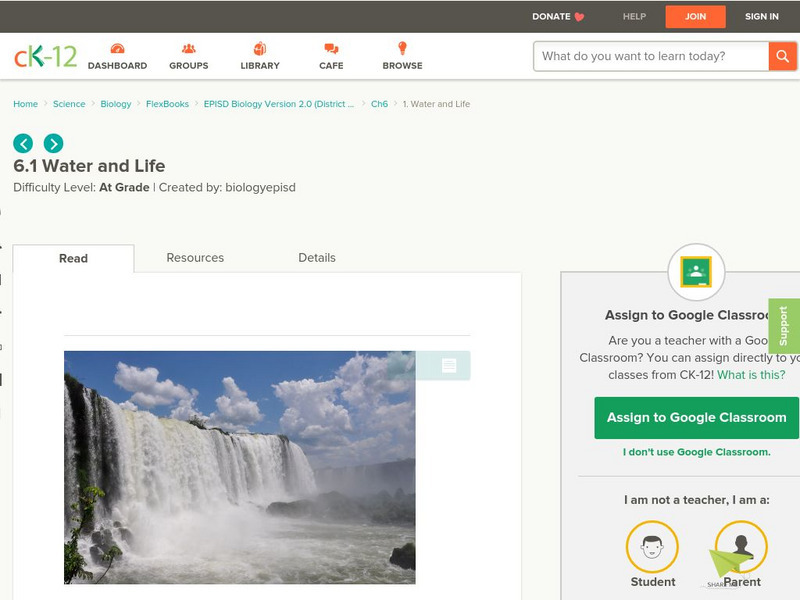Clackamas Community College
Clackamas Community College: Chemical Bonding: Metals and Nonmetals
A chart of the periodic table of elements, including showing the nonmetal group.
Simon Fraser University
Chem1 Virtual Textbook: States of Matter [Pdf]
Through a series of five related sections, this 24 page pdf file examines a range of topics associated with states of matter including physical interactions between molecular units, bonding within molecular units, molecular units of...
TeachEngineering
Teach Engineering: Density & Miscibility
After students conduct the two associated activities, Density Column Lab - Parts 1 and 2, present this lesson to provide them with an understanding of why the density column's oil, water and syrup layers do not mix and how the concepts...
Vision Learning
Visionlearning: Biological Molecules: Fats and Proteins
An explanation of the importance of fats and proteins in the human diet. Examples of chemical structures of various fats and proteins are used.
University of Hamburg
University of Hamburg: Polysaccharides
Brief description of polysaccharides includes definition, chemical composition, and formation.
Chemistry Collective
Chem Collective: Metal Ligand Binding
Use silver chloride to determine the binding constant for a metal ligand complex.
University of California
Organic Chemistry Page: A Brief Tutorial on Drawing Lewis Dot Structures
An excellent lesson on writing Lewis structures. Examples shown include ammonium ion, carbon dioxide and the carbonate ion.
Other
University of South Carolina: Resonance in Lewis Structures
A slide show with several slides dedicated to the topic of resonance in Lewis structures. Diagrams help illustate the examples. A practice example is provided.
CK-12 Foundation
Ck 12: Electron Arrangement in Atoms
[Free Registration/Login may be required to access all resource tools.] In the following online tutorail students will learn how to express the arrangement of electrons in atoms through electron configurations and Lewis valence electron...
American Chemical Society
Middle School Chemistry: Lesson Plans: Why Does Water Dissolve Salt?
Students use their own model of a salt crystal and water molecule to show how water dissolves salt. Then, they relate their observations to the structure of salt, water, and alcohol on the molecular level.
American Chemical Society
Middle School Chemistry: Lesson Plans: Why Does Water Dissolve Sugar?
Lesson plan in which students design an experiment to determine if different types of liquids affect the amount of dissolution of an M&M candy shell.
Wikimedia
Wikipedia: Amide
Wikipedia entry for the chemical compound amide. Includes naming conventions, properties, reactions, and so on.
Concord Consortium
Concord Consortium: Nonbonding
Bring two molecules together and observe potential energy changes.
Simon Fraser University
Chem1 Virtual Textbook: Electron Tunneling Model
Find out about shared electrons between the two nuclei. Learn about uncertainty at work.
Davidson College
Davidson College: Network Solids: Crystalline Solids
Explains the differences between ionic, molecular, metallic, and network crystalline solids. Displays structures for diamond, graphite, fullerene, and silica, accompanied by questions about their chemical bonding. Electron density plots...
National Health Museum
Access Excellence: Linus Pauling (1901 1994)
This Access Excellence site provides a general biography of Linus Pauling, the two-time Nobel laureate who the elucidated chemical bonding, amino acid and protein structures, and the molecular basis of sickle-cell anemia.
Other
Beautiful Chemistry: Beautiful Structures: Metal Organic Frameworks
Interact with these virtual structures of metal-organic frameworks. These special kinds of crystals are made of organic molecules and metal-containing units, which are linked together by chemical bonds.
Biology Pages
Kimball's Biology Pages: Electronegativity
This site, which is a personal site from Kimball's Biology, provides an overview with multiple examples of electronegativity.
CK-12 Foundation
Ck 12: Organic Reactions
[Free Registration/Login may be required to access all resource tools.] Students distinguish between substitution reactions and addition reactions, and relate the concepts of oxidation and reduction to organic reactions.
CK-12 Foundation
Ck 12: Water and Life
[Free Registration/Login may be required to access all resource tools.] The chemical and physical properties of water are examined in this lesson, including the role of hydrogen bonds in determining water's properties. The importance of...
Simon Fraser University
Chem1 Virtual Textbook: Enthalpy Diagrams
With an overview of topics related to chemical energetics, this site provides a foundation to a study of thermodynamics and its relation to enthalpy. Topics covered include bond enthalpies and bond energies, energy content of fuels,...
University of Utah
University of Utah: Genetic Science Learning Center: What Causes Dna Mutations
Provides a great overview of DNA damage from agents such as ultraviolet light, nuclear radiation, and certain chemicals. Includes DNA strand drawings.
CK-12 Foundation
Ck 12: Properties of Water
[Free Registration/Login may be required to access all resource tools.] Students look at the chemical structure of water and learn how it determines water's properties.
American Chemical Society
Middle School Chemistry: Why Does Water Dissolve Sugar?
Explore this animation to learn why water dissolves sugar.
Other popular searches
- Chemical Bonding Lesson Plan
- Chemical Bonding Crossword
- Chemical Bonding Activity
- Edible Lab Chemical Bonding
- Chemistry Chemical Bonding
- Chemical Bonding Ionic
- Chemical Bonding Inquiry
- Worksheets Chemical Bonding
- Chemical Bonding Case Study
- Chemistry Chemical Bonding
- Matter and Chemical Bonding
- Science Chemical Bonding













